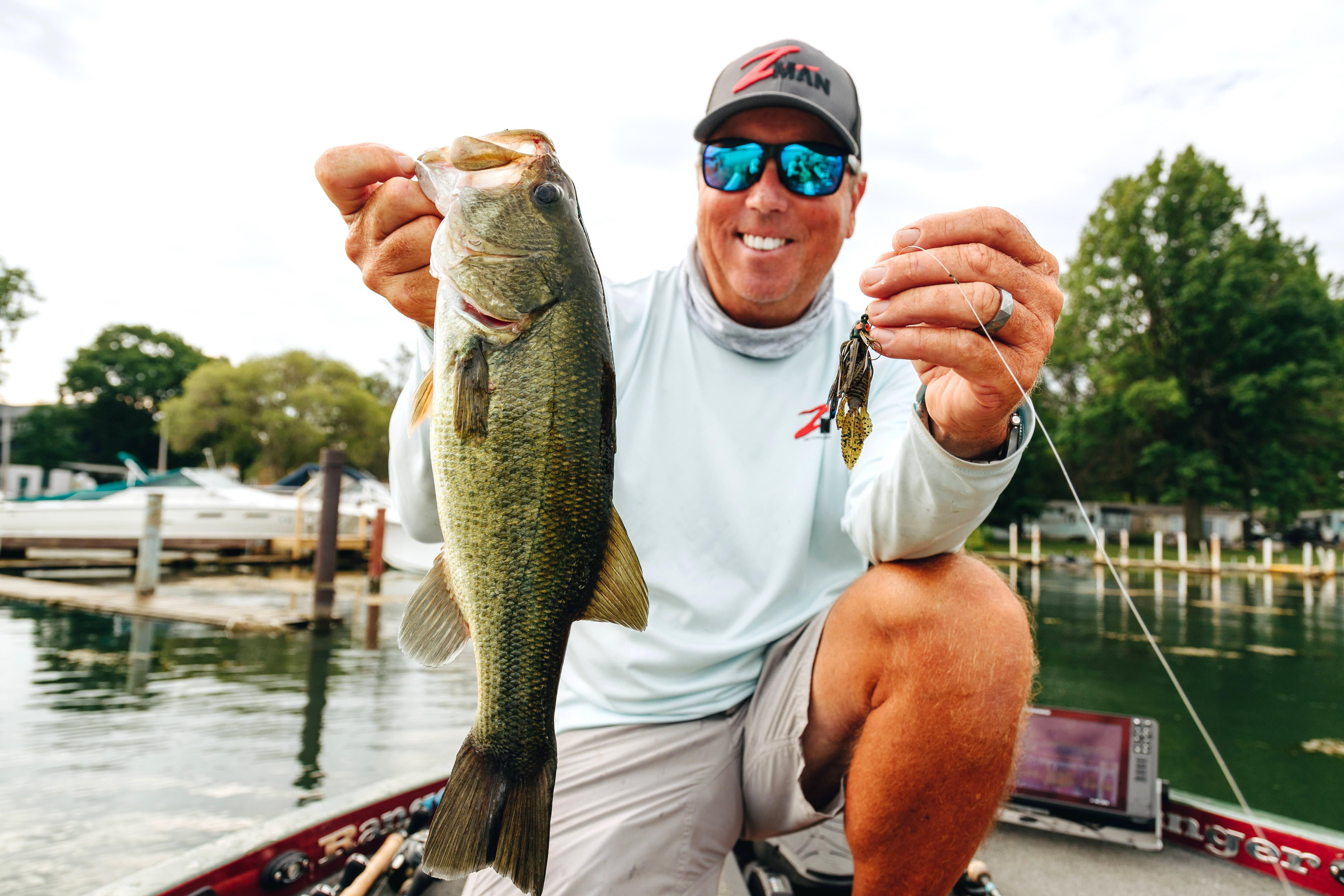Marinas offer cover, food, and outstanding summer action for everything from crappies and catfish to bass and bream. Here’s how to fish them
Every day, anglers all across America jump in their boats and race off to their favorite fishing spots. Many of them are leaving the best fishing in the area behind them, in a spot that requires no boat ride at all. Many boat marinas hold quality fish year around, but they really come into their own in summer. Deep water and flushing currents set the stage. Shady boat docks, riprap banks, and concrete ramps seal the deal. And it’s not just bass that flock to marinas. A number of species inhabit these warm-water sanctuaries, increasing your chances for a great day on the water.

Don’t race past what might be the most productive water on the lake in a rush to leave the marina. Image by Joe Balog
Let’s dig in.
FINDING A MARINA TO FISH
It’s pretty easy to distinguish a productive summertime marina from the rest, as a single variable supersedes the rest: deep water. Skip the marinas located in the backs of creeks or shallow coves. Instead, head to locations on the main lake or river channel; the bigger and deeper, the better. You’ll know a marina has potential when it’s home to big cruiser boats, as those owners won’t put up with shallow water and the potential for running aground.

A good marina features deep water, nearby structure and moving current. Image by Jason Sealock
If a number of potential hotspots exist, always pick a marina with docks on or near a main lake point, or on a river-channel bank with a steep shoreline. This not only satisfies our deep-water needs, but adds an element of structure and possibly brush and other cover.
Finally, if possible, choose a marina that offers direct access to the main lake or flowing current. More about that follows.
Don’t Miss: THE 5 BEST STATES FOR BASS FISHING
GO WITH THE FLOW
Take a step back and assess the situation. Think in terms of water flow. Where might current and fresh water enter your chosen marina, and where will it leave? That’s easy to determine in a river scenario, but a wide-angle view is required in a lake. Most often, large marinas sit on main lake areas where winds blow significantly against one perimeter. Perhaps there’s a large seawall or embankment blocking the marina off. If that’s the case, wind will often produce a current that wraps into the marina entrance.
Another look reveals that the marina entrance itself is a “neck-down” spot. Winds blowing through the marina will push water through that narrow funnel and produce a flow. In some instances, marinas use bubblers to prevent aquatic weeds form blowing in. These, too, produce a noticeable current that ebbs and flows in and around boat docks and walls.
It’s important to get a birds-eye view of how the water flows in and out of your fishing spot, especially in a marina. Those areas nearest the flow will always be best in the summertime (but often less productive in cold temps). This time of year, focus your efforts near current, regardless of your quarry.
Don’t Miss: HOW TO CHOOSE A GREAT FISHING ROD
FIND YOUR FISH
Depending on what type of fish you’re after, it’s likely lurking in a productive marina. Consider these tactics for the primary players:
Crappies
A schooling fish by habit, crappies really bunch up in summer. They’ll hang in the shade of the deepest boat docks, eternally suspended and seemingly oblivious to water depth. Crappies can sometimes be found over 100 or more feet of water this time of year, but will seldom be more than 20 feet down.
You’re most likely to encounter crappies slightly out of the main channel or areas nearest harbor entrances. They seem to like to be tucked in a bit, still near the open water areas of big marinas, but out of the main drag.
Affinity with sonar, specifically forward-facing units, is the easiest way to find these fish. From there, presenting a small plastic will get the job done. Try a 3-inch swimbait or 2-inch grub on a 1/8-ounce head. Often, skipping the lure far back beneath the dock is necessary, especially in the afternoon.
An overlooked option for marina crappies in summer is night fishing. They’ll move toward the outside edge of cover, and respond to live bait or jigs beneath a slip bobber. A soft glow of a lantern or black light will draw them in as it also attracts minnows. The best time is often several hours after dusk.
Bass
Largemouth are the most popular freshwater fish, especially in summer, when most anglers swap out their panfish gear for pitchin’ sticks. Summer bass love marinas, as they provide host to a variety of food items, from bluegills hanging near docks, to crayfish on riprap banks, to massive schools of open-water shad.

From small bluegills to crayfish to schools of shad, marinas offer a ready and plentiful food source to attract and hold bass. Image by Jason Sealock
Threadfin shad will often spawn in the early summer, frequently in marinas, creating the ultimate bass bite. This is a dawn and dusk affair, with the best action occurring in the first hour of daylight. You’ll know when you’re around spawning shad because they’ll follow in your spinnerbait or Chatterbait. Look for them around dock floats, or up against a riprap bank. It’s easy fishing when it’s happening, just be sure to only fish about 6 inches down.
The rest of the day, bass will take up residence in the shadowy recesses of docks, often suspending over deep water. They’re noticeable on sonar, and readily take properly presented jighead minnow rigs and swimbaits. If FFS is not your game, try skipping a Senko into the shadows, and forget about water depth. Count to ten, and reel it back in.
Other times, bass are hunting bluegills and will be shallower around cover, dock poles or — if available — bream beds. These panfish spawning aggregations can usually be found in 4 to 8 feet of water on secondary points, or areas that are shallower and flatter than surrounding deep banks. Find the bream beds, and you’ll find bass, all day. Fish them with crankbaits or topwater poppers.
Never count out seawalls for bass, either, especially when a moderate wind blows in on them. There, a jig is usually the ticket when pitched up close. Rocky points within marinas can also be dynamite.
Don’t Miss: 5 TRAITS THE BEST BASS PROS HAVE IN COMMON
Bluegills and other bream
Bream suspend like crappies, but more readily relate to floating boat docks and poles. There, they’ll feed on small invertebrates attracted to moss-covered items. Even an errant dock line dropped in the water can attract a school of big bluegills.

Bluegills and other panfish key in on the structure provided by floating boat docks and vertical support poles. Image by Jason Sealock
Bream can be anywhere, really, shallow or deep. Always keep an eye out for areas with weed growth. Cover in the water — treetops, ladders — increases your odds of contacting bruiser bream.
If looking for redears / shellcrackers, stay away for deep water and search out hard-bottom areas in shallow water, from 3 to 6 feet. They’ll bed there in the summer. Fish by dragging small plastics or red worms on a float just above bottom.
For other species, look deeper and, again, directly against floating docks. Use a stealthy approach when moving into shady areas and you’ll often see bream just below the surface.
Live bait and plastics work, but a flashy bait like an inline spinner, run just below the surface, can really score. The same can be said for little Rapala or panfish-style crankbait. Keep moving until you find the fish; you’ll know when you do. Bigger fish run in groups.
Don’t Miss: HOW TO USE ARTIFICIAL LURES FOR BREAM FISHING
Catfish
Catfish are underrated, especially in summertime when most anglers turn their attention to bass. The die-hard catfishermen who remain usually take to rivers or tailraces for the best action. But marinas can produce, too.
Cats will move into the deep-water sanctuaries where they feed on shad along with the other predators. They will be in areas with the most current nearly every time, so look for pinch points. If bridges or causeways are available, even better. Catfish also like to spend time on the outer sections of large boat ramps, down where concrete turns to natural bottom. That can be a good place to stake out.
Typical cat fishing approaches apply; live and cut baits, as well as doughs and dips. Try to find deep water depressions or holes adjacent to shallower areas. In reservoirs, look for channel banks around docks, preferably with poles or brushy cover. Don’t bother fishing ultra-deep; cats will be in the mid-depth range where light reaches bottom and cover is available.
Stripers
Stripers and hybrids are a lot like largemouth in terms of their preference for deep marina areas that hold lots of bait. There, they find shad schools too irresistible to pass up, and often move in and out on feeding binges. When they come into marinas, stripers will almost always be in the large, open-water expanses. They’ll corral shad and can often be seen blowing up on the surface. Sometimes stripers will even use a dock or seawall to pin down their food source. Wind can help or hurt, depending on how much it moves the bait.

Stripers and hybrids often key in on the massive schools of shad located in many marinas. Image by Joe Balog
Savvy striper anglers often fish at night. The fish will cruise much closer to the surface, and are susceptible to big spoons and topwater baits. With the right gear, dock anglers can cast a mile. If you don’t have access to fishing from a dock, move in quietly with a boat and sit still, taking it all in to find out where the action is. The stripers will be in and around the biggest schools of shad, every time.
Marinas can be a real freshwater bonanza in summer, regardless of what you’re fishing for. The key is to understand the water flow within, and pick fishing spots purposely.
Don’t run around looking for fish this summer. Instead, let them come to you.












